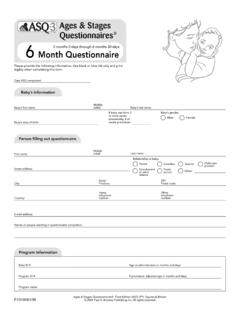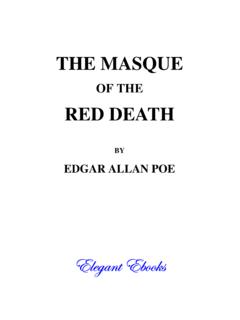Transcription of Ages & Stages Questionnaires 42 Month …
1 ages & Stages Questionnaires , Third Edition (ASQ-3 ),Squires & Bricker 2009 Paul H. Brookes Publishing Co. All rights filling out questionnaireChild s informationDate ASQ completed:Relationship to child:ParentStreet address:Names of people assisting in questionnaire completion:Grandparent or other relativeGuardianFoster parentTeacherChild care providerOther: ages & StagesQuestionnaires Month Questionnaire39 months 0 days through 44 months 30 daysPlease provide the following information. Use black or blue ink only and printlegibly when completing this s first name:Child s last name:Child s date of birth:First name:Last name:Middle initial:City:Home telephone number:State/Province:ZIP/Postal code:Other telephone number:E-mail address:Child s gender:MaleFemaleMiddle initial:Country:Program InformationChild ID #:Program ID #:Program name: ages & Stages Questionnaires , Third Edition (ASQ-3 ),Squires & Bricker 2009 Paul H.
2 Brookes Publishing Co. All rights 2 of 7E101420200 Month Questionnaire4239 months 0 days through 44 months 30 daysImportant Points to Remember: Try each activity with your child before marking a response. Make completing this questionnaire a game that is fun foryou and your child. Make sure your child is rested and fed. Please return this questionnaire by :_____On the following pages are questions about activities children may do. Your child may have already done some of the activitiesdescribed here, and there may be some your child has not begun doing yet. For each item, please fill in the circle that indicateswhether your child is doing the activity regularly, sometimes, or not Without giving your child help by pointing or using gestures, ask him to put the book onthe table and put the shoe underthe chair.
3 Doesyour child carry out both of these directions correctly?2. When looking at a picture book, does your child tell you what is hap-pening or what action is taking place in the picture (for example, bark-ing, running, eating, or crying )? You may ask, What is the dog(or boy) doing? 3. Show your child how a zipper on a coat moves up and down, and say, See, this goes up and down. Put the zipper to the middle, and askyour child to move the zipper the zipper to the middle,and ask your child to move the zipper this several times, placingthe zipper in the middle before asking your child to move it up ordown. Does your child consistently move the zipper up when you say up and down when you say down ?4. When you ask, What is your name?
4 Does your child say both her firstand last names?5. Without your giving help by pointing or repeating directions, does yourchild follow three directions that are unrelatedto one another? Give allthree directions before your child starts. For example, you may ask yourchild, Clap your hands, walk to the door, and sit down, or Give methe pen, open the book, and stand up. 6. Does your child use all of the words in a sentence (for example, a, the, am, is, and are ) to make complete sentences, such as Iamgoing to thepark, or Isthere atoy to play with? or Areyoucoming, too? YESSOMETIMESNOT YETCOMMUNICATION TOTALGROSS MOTOR1. Does your child walk up stairs, using only one foot on eachstair? (The left foot is on one step, and the right foot is on the next.)
5 He may hold onto the railing or wall. (You can look for this at a store, on a playground, or at home.)2. Does your child stand on one foot for about 1 second without holding onto anything?3. While standing, does your child throw a ball overhandby raising his arm to shoulder height and throwing the ball forward? (Dropping the ball or throwing the ball under-hand should be scored as not yet. )4. Does your child jump forward at least 6 inches with both feet leaving the ground at the same time?5. Does your child catch a large ball with both hands? (You should stand about 5 feet away and give your child two or three tries before you mark the answer.)6. Does your child climb the rungs of a ladder of a playground slide andslide down without help?
6 FINE MOTOR1. After your child watches you draw a single circle with a pencil, crayon, or pen, ask him to make a circle like yours. Do not let him trace your circle. Does your child copy you by drawing a circle? ages & Stages Questionnaires , Third Edition (ASQ-3 ),Squires & Bricker 2009 Paul H. Brookes Publishing Co. All rights Month Questionnairepage 3 of 7E101420300 YESSOMETIMESNOT YETGROSS MOTOR TOTALYESSOMETIMESNOT YETC ount as not yet Count as yes FINE MOTOR(continued)2. After your child watches you draw a line from one side of the paper to the other side, ask her to make a line like yours. Do not let your child trace your line. Does your child copy you by drawing a single line in a horizontal direction?3. Does your child try to cut paper with child-safe scissors?
7 He does not need to cut the paper but must get the blades to open and close while holding the paper with the other hand. (You may show your child how to use scissors. Carefully watch your child s use of scissors for safety reasons.)4. When drawing, does your child hold a pencil, crayon, or pen between her fingers and thumb like an adult does?5. Does your child put together a five- to seven-piece interlocking puzzle?(If one is not available, take a full-page picture from a magazine or cata-log and cut it into six pieces. Does your child put it back together cor-rectly?)6. Using the shape at right to look at, does your child copy it onto a large piece of paper using a pencil, crayon, or pen, without tracing? (Your child s drawing should look like the design of the shape, except it may be different in size.)
8 PROBLEM SOLVING1. When you point to the figure and ask your child, What is this? does your child say a word that means a person or something similar? (Mark yes for responses like snowman, boy, man, girl, Daddy, spaceman, and monkey. )Please write your child s response here:2. When you say, Say seven three, does your child repeat justthe twonumbers in the same order? Do not repeat the necessary,try another pair of numbers and say, Say eight two. (Your child mustrepeat just one series of two numbers for you to answer yes to thisquestion.)3. Show your child how to make a bridge with blocks, boxes, or cans, like the example. Does your child copy you by making one like it? ages & Stages Questionnaires , Third Edition (ASQ-3 ),Squires & Bricker 2009 Paul H.
9 Brookes Publishing Co. All rights Month Questionnairepage 4 of 7E101420400 YESSOMETIMESNOT YETFINE MOTOR TOTALYESSOMETIMESNOT YETC ount as yes Count as not yet PROBLEM SOLVING(continued)4. When you say, Say five eight three, does your child repeat justthethree numbers in the same order? Do not repeat the neces-sary, try another series of numbers and say, Say six nine two. (Yourchild must repeat just one series of three numbers for you to answer yes to this question.)5. When asked, Which circle is the smallest? does your child point tothe smallest circle? (Ask this question withoutproviding help by point-ing, gesturing, or looking at the smallest circle.)6. Does your child dress up and play-act, pretending to be someone orsomething else?
10 For example, your child may dress up in differentclothes and pretend to be a mommy, daddy, brother or sister, or animaginary animal or When he is looking in a mirror and you ask, Who is in the mirror? does your child say either me or his own name?2. Does your child put on a coat, jacket, or shirt by herself?3. Using these exact words, ask your child, Are you a girl or a boy? Does your child answer correctly?4. Does your child take turns by waiting while another child or adult takesa turn?5. Does your child serve himself, taking food from one container to an-other using utensils? For example, does your child use a large spoon toscoop applesauce from a jar into a bowl?6. Does your child wash his hands using soap and water and dry off with atowel without help?






